Feature
From Surviving to Thriving
Teaching social emotional learning alongside the NGSS
The Science Teacher—March 2020 (Volume 87, Issue 7)
By Anna Bahnson, Jesse Wilcox, Jerrid Kruse, and Timothy Schou
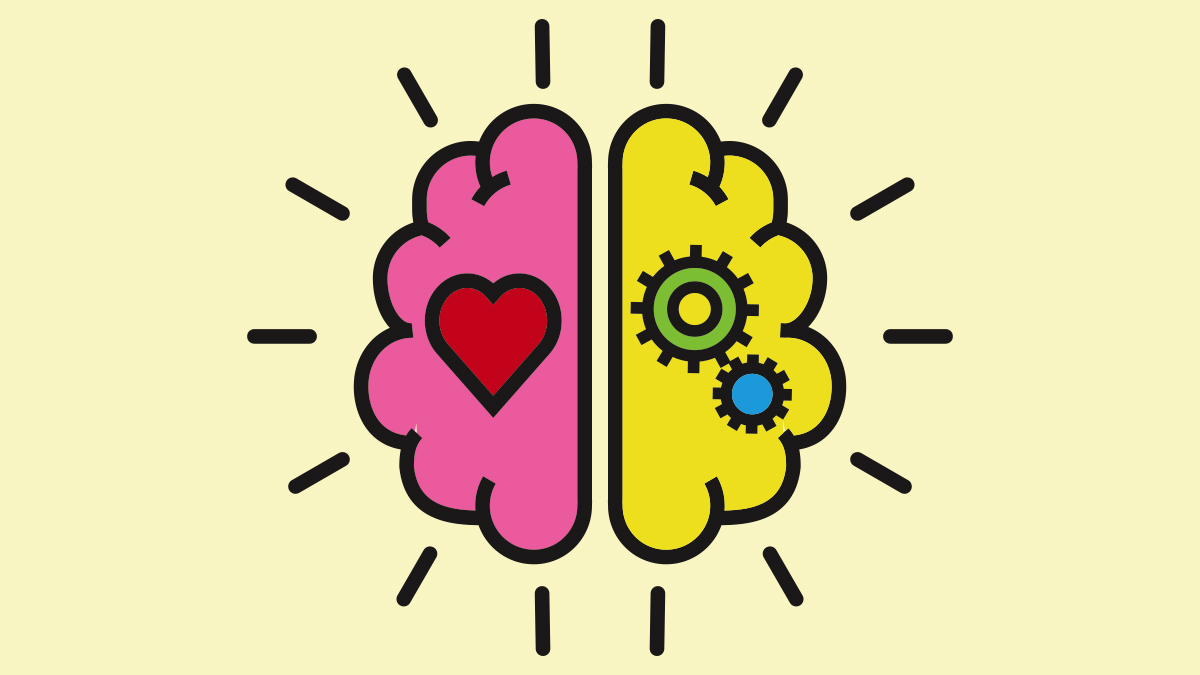
The science and engineering practices in the Next Generation Science Standards seek to engage students in complex tasks including planning and carrying out investigations or engaging in argument from evidence. However, such tasks often require students to effectively collaborate. While our students get better at working together in an inquiry environment as the school year progresses, we have found teaching social and emotional learning skills has helped students see the connections between engaging with the science and engineering practices and everyday life. This two-day activity about group behavior (HS-LS2-8) blends the three dimensions of the Next Generation Science Standards and explicitly helps our students develop socially and emotionally.
Social Emotional Learning
Social emotional learning (SEL) refers to learning how “to understand, manage, and express the social and emotional aspects of one’s life” (Elias et al. 1997). SEL has both intrapersonal and interpersonal dimensions (CASEL 2019). Intrapersonally, SEL helps make students aware of and manage their emotions. Interpersonally, SEL helps students build relationship skills and make them aware of social situations. In both cases, SEL helps students make responsible decisions. SEL has been shown to improve student engagement, motivation, and academic success (Durlak et al. 2011); however, adding SEL to lessons can be difficult. Here we explore a few ways to embed SEL in any lesson effectively.
Components of SEL
Creating a supportive classroom
Creating a supportive classroom climate lays the foundation for teaching SEL. Early in the year we emphasize building relationships with and between students. When interacting with students, we model encouraging behaviors by using positive non-verbal cues, such as smiling, eye contact, and leaning forward while helping students think through their ideas rather than rejecting them (Bergman 2018). In addition, we collaborate with students to create classroom expectations. When these expectations aren’t met, we work to help students reflect on how their behavior affects our classroom environment. All of these actions taken together build a welcoming, caring, and participatory community that models SEL.
Inclusivity
We work to create an inclusive environment by being intentional about the language we use (e.g., avoiding “guys,” expressing our preferred pronouns). We try to connect personally with each student and use a checklist to help us keep track of our interactions to ensure no students are slipping through the cracks. We also use many ideas from Emdin’s (2016a, 2016b) work on the Seven Cs for Effective Teaching. Specifically, we use what Emdin calls cogenerative dialogues, or cogens, by meeting with small groups of students to discuss what changes might be needed to improve the class. We also work with students to coteach lessons throughout the year, which has improved the relevance to students’ everyday lives and provides them with some empathy for the rigors of teaching. Additionally, we try to visit students in their own context (e.g., plays, sports, clubs, community events) to build strong teacher-student relationships. These approaches help us show each student we care about them, which helps us engage students in SEL.
Teaching science through inquiry
Creating a supportive and inclusive classroom helps us develop the environment necessary to teach science through inquiry effectively. Teaching science through inquiry refers to the pedagogical decisions and actions teachers make to promote collaboration, decision-making, and a deep understanding of fundamental science ideas (Wilcox, Kruse, and Clough 2015). This approach to teaching provides numerous opportunities for students to practice SEL concepts in an authentic way. For example, in an inquiry-based classroom, students are encouraged to share their ideas and use evidence to support their thinking. Thus, students must advocate for their ideas while also taking into consideration the social environment in which they find themselves by paying attention to the social and emotional cues of others.
Explicit and reflective SEL questions
While the strategies above are necessary for creating an environment for effectively promoting SEL, teachers must also explicitly draw students’ attention to SEL concepts and have them reflect on those concepts throughout the school year (Table 1). Sometimes we engage students with these sorts of questions with a bell-ringer or a quick write. Other times, we ask them questions within the lesson such as, “We are going to work on a lab today. What are two ways you will practice responsible decision making?”
Embedding SEL within a simulation of group behavior and survival
We explicitly address SEL within our ecology unit when we teach an inquiry activity about group behavior and survival (HS-LS2-8). We use a simulation to engage our students in three-dimensional learning while helping them reflect on SEL concepts and the importance of inclusivity.
Day 1: Simulation and data collection
Before class begins, we evenly disperse beads on a table labeled as food. At the other end of the classroom, we label the tables as a home nest for each student to place their assigned cups and beads during the simulations. The cups are numbered to help with grouping in later rounds. If classroom space is limited, a good alternative is to take the students outside, to the cafeteria, or to the gym to do this activity.
Start with a brief review of animal interactions in ecosystems by asking, “What are some ways predators obtain their food?” We then introduce our simulation by asking students to line up on one side of the room and state, “In one minute, I want each of you to gather as much food from the other side of the room as possible and return it to your home.”
To alleviate classroom management issues, we ask, “What should safe behavior look like when we are running this simulation?” Students often suggest “no running or pushing,” “no goofing around,” and “watching where we are going.” After we are confident students understand the task and the rules, we run the simulation (Figure 1). When we have students with physical limitations, we speak with them before class about how they want to participate. For example, one of our students who lacked large motor control simply wanted to hold the cup for his team.
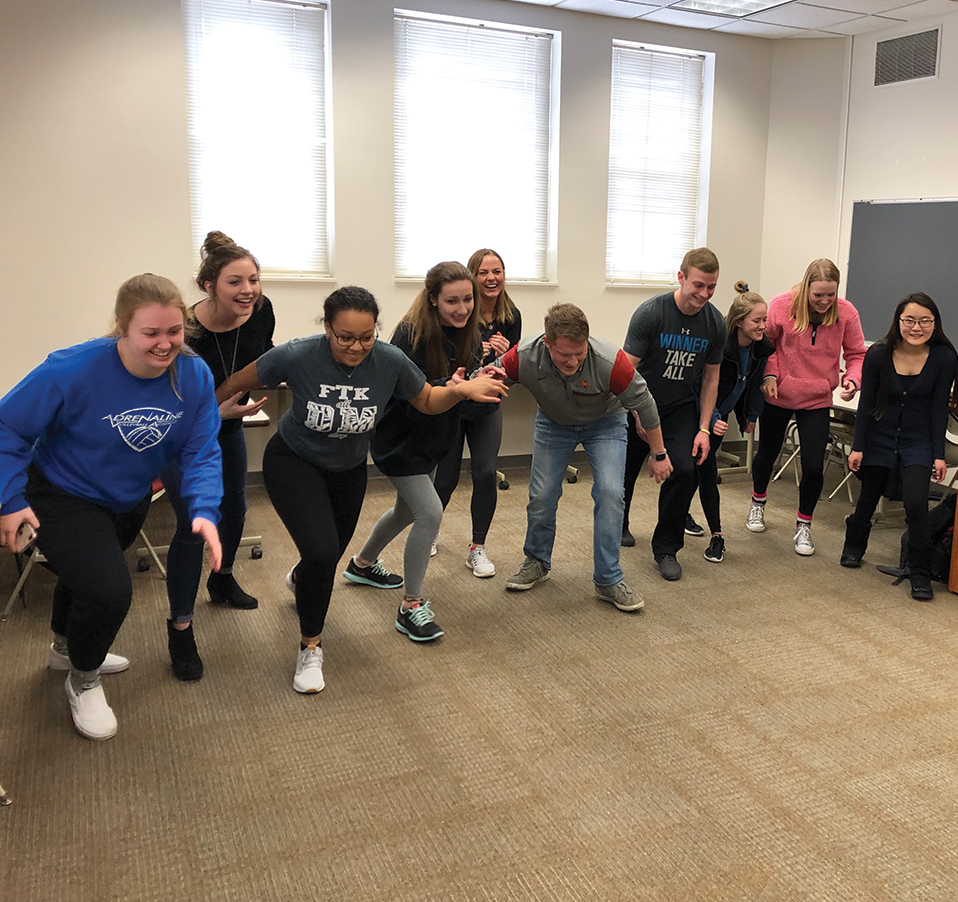
Students start the simulation
Afterward, students tally and record their scores on sticky notes and compare with others to see who is most likely to survive. Students often find themselves hooked, eager to run the simulation again to beat another student’s score or to improve on their own. We tell them we are going to do a second round, but are adding a twist: They will be in groups of two and we introduce competition by asking students, “In what ways do animals compete against each other in nature?” We then tell them they are allowed to steal beads—one at a time—from another group’s nest until a member from the group getting robbed returns. Students have two minutes to come up with a plan to ensure they will both survive. We remind students that the main objective is collecting food, not battling other pairs. Students typically plan for one person to guard the nest and one person to gather food.
To save time in this activity, some teachers may be tempted to tell students how to behave in another round of the simulation. However, it is imperative to allow students time to plan and design as they develop critical-thinking and teamwork skills by engaging in more authentic inquiry. In addition, allowing students time to work together to establish their plan sets the groundwork for later explicit reflections regarding social and emotional learning.
Once students have tested their plans in the second round, we engage them in a pair share by asking, “What changed about the amount of food you were able to collect?” Students note they collected fewer beads per person. We then ask, “Why might organisms reduce their efficacy to collect food by leaving one animal to guard their home?” Students note animals might want to protect their offspring or protect their territory. We then ask, “How might having more people in a group help you?”
For a third and final round, we use assigned cup numbers to form groups of four and allow an additional two minutes for restructuring their plan for gathering food. Typically, groups decide to form an assembly line to pass beads to the nest (Figure 2). Once students finish this final round, we have them record the following on the board: Sum of food from round 1 (gathered as individuals) Sum from round 2 (gathered in pairs with added competition) Sum from round 3 (gathered in groups)
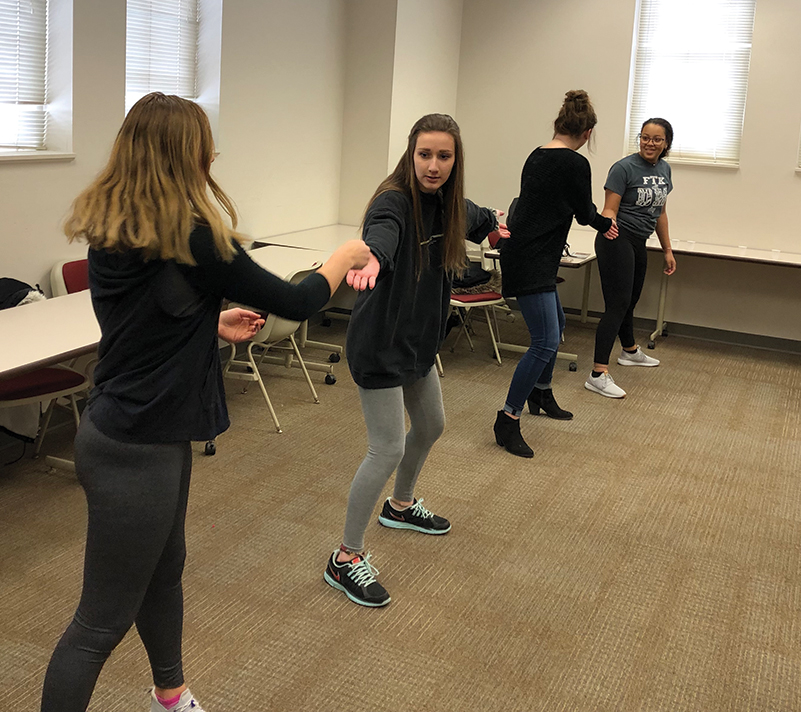
Students form an assembly line to pass beads to the nest.
After the data for all three rounds are recorded and averaged, we draw their attention to the crosscutting concept of cause and effect by having them discuss: “What patterns are you noticing about your data?” Based on the patterns they observe, we give students the opportunity to share why they think some rounds were more successful than others. We have students engage in a write-pair-share to see if students understand the purpose of each round of the simulation and if they understand the causes and effects. We walk around the room, look at their writing, and listen to their conversations.
We encourage them to graph their data to better visualize trends (Figure 3) and we differentiate by asking scaffolding questions when necessary, such as, “What was different about the second round beyond working with a partner?” During the “share” portion of the write-pair-share, students often note that the first round just simulated survival, but the later rounds simulated protecting their young and territory, competition, and working in groups.
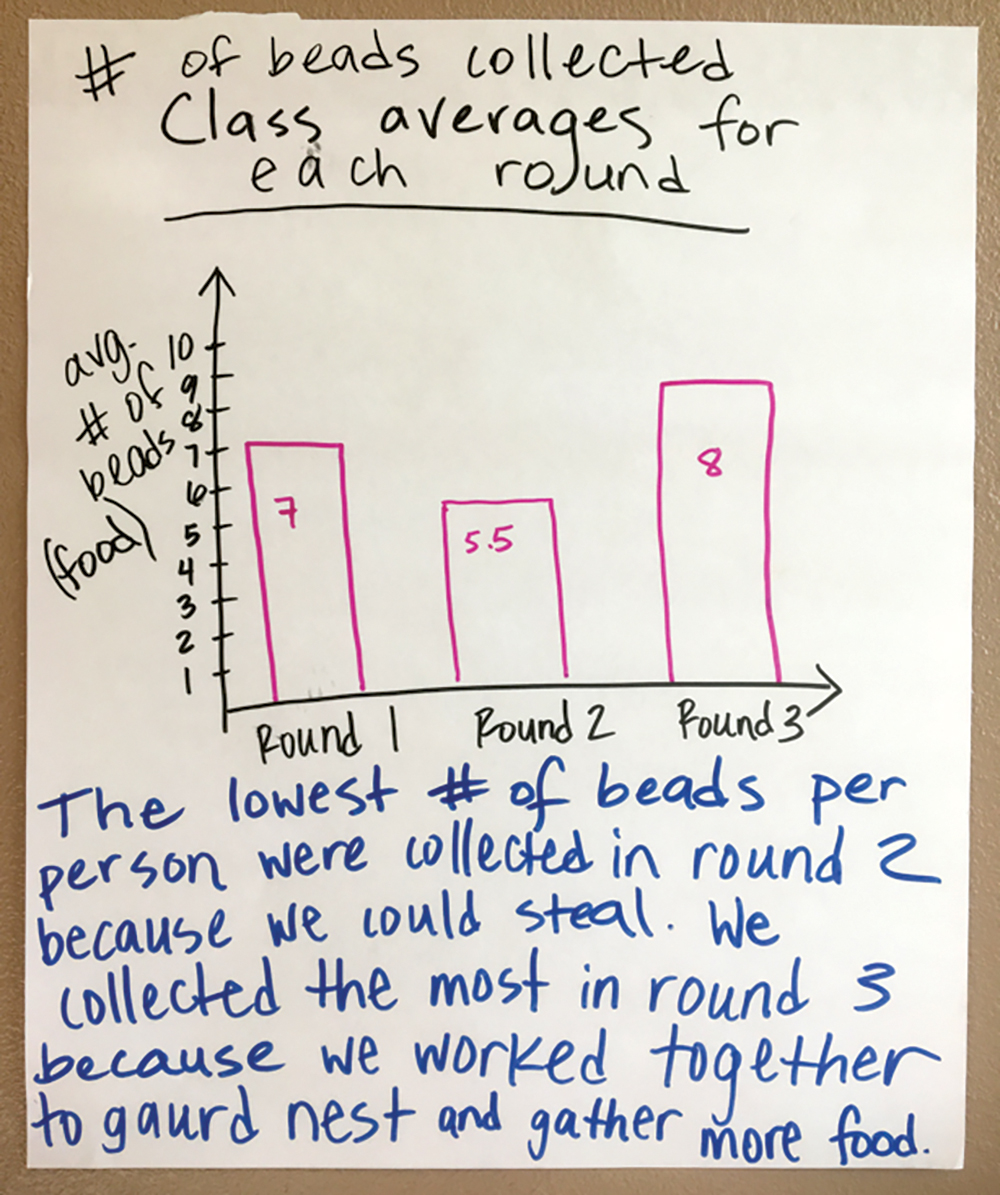
Graphing the data to visualize trends.
Questions we ask to get students thinking about the connections between individual and group behaviors include: “How might an individual act differently than when they are in a group?” and “In what ways was working in a group beneficial?” Students note they might not directly benefit in a group, but overall, a group spreads out the workload. We then ask, “During the simulation, what worked well and what didn’t work well?” Students often observe groups that clearly communicated a plan did better than groups that just jumped in and tried the simulation.
Students sometimes see a disconnect between animals and humans even though behaviors such as consumption, survival, and reproduction are a part of all animal lives (Driver et al. 1994). To help students see how humans engage in animal behaviors and to help students make connections to social and emotional learning more explicitly, we ask questions such as: If group behavior is advantageous in nature, how might this apply to humans? Why might humans have similar behaviors for the same reasons animals do? What connections can you make between this lesson and SEL concepts we have discussed in class? What are some ways you worked to improve the simulation? What, if any, connections could you use here to improve your interactions with others in your daily life? How did effective communication help your group “survive”? In what sense does effective communication improve your life?
Day 2: Linking the simulation to the real world
During the second day, we help students see how the simulation demonstrates organisms interacting in the natural world. We show videos of animals working together in nature (see sidebar for video examples). We make sure that some of the videos of animal behaviors are very similar to the group simulation (e.g., emperor penguins watching their chicks), while other videos display different group behaviors (e.g., ants creating a lifeboat, bees swarming).
To engage students during the videos, we have them write responses to: “What behaviors do you observe in the animals?” and “In what ways are the behaviors similar to what we experienced in our simulation?” Students usually note that the animals are working together, but need more scaffolding to see how these behaviors connect to survival and reproduction.
We ask more targeted questions after students watch the videos, such as: “In what ways does group work increase the survival rates of killer whales?” or “How does the behavior observed in the fieldfare birds help their young survive?” Students note how multiple whales are needed to create large waves to catch their prey, and how numerous birds distract the raven so their young are not killed.
| Table 1. Social-emotional concepts and explicit/reflective questions. | ||||||||||||
|---|---|---|---|---|---|---|---|---|---|---|---|---|
|
To help students develop a deeper understanding of the role of group behavior, we have them read, “Swarming up a Storm: Why Animals School and Flock.” We formatively assess their understanding of the article by asking, “What claim do the researchers make and what evidence and reasoning do they use to back up their claim?” To further assess their understanding of group behavior, we present students with a video of fieldfare birds and their interactions with ravens, then ask them individually to explain how the group behaviors of these animals help them better survive.
To make further connections to SEL, we ask students to think back to the simulation again. To help them make connections to their own emotions we ask: “What sorts of emotions did you feel during the simulations?” and “How do you think someone’s emotions might affect the way they play the game?” These intrapersonal reflections help students develop a deeper awareness of how their own feelings might affect their reactions to everyday situations.
During these SEL conversations, and in fact during all of our class discussions, we are sure to remain neutral when responding to students. We try to ask for more information or clarification, and work hard to not reject or confirm students’ ideas. Instead, we try to acknowledge what students say so they know they are heard.
We also work to help students engage in interpersonal reflection. For example, we ask students, “How did the teams in round 2 affect the way you related to your classmates?” Students quickly note that their team saw everyone else as enemies and only trusted each other. We make connections to social dynamics by asking, “How does this process of ‘othering’ create conflict in our society?” This question opens up our discussion to a wide range of topics, but they are important issues that our students are dealing with including: racism, sexism, xenophobia, social pressures, etc.
Importantly, these conversations happen only after we have developed strong relationships with our students and after they have practiced having difficult conversations and learned to disagree with each other in productive ways. As the discussion comes to a close, we are sure to focus the students back to productive avenues by asking, “Given that a sense of tribalism was so easy to develop within this classroom during a simple simulation, why should we be skeptical when people try to convince us that someone, or some group, doesn’t belong?”
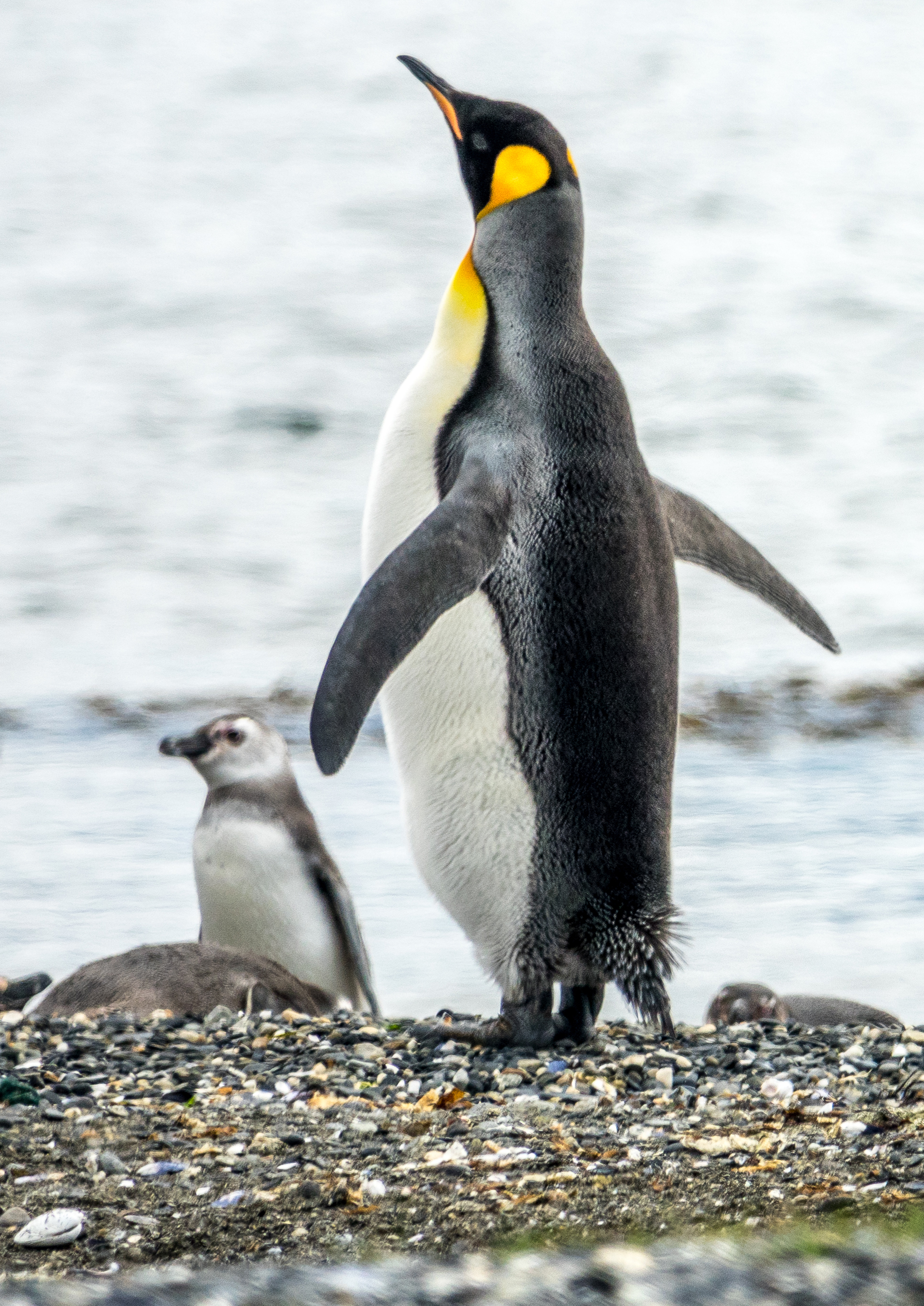
Killer whales working together to hunt seals: www.youtube.com/watch?v=g1VEwsI4SlY
Ants create lifeboat in the Amazon jungle: www.youtube.com/watch?v=A042J0IDQK4
Fieldfare birds defend their young against a raven: www.youtube.com/watch?v=Fdrl__ggV9k
Emperor penguin male watches chick while female hunts: www.youtube.com/watch?v=MfstYSUscBc
Day 3: Summative assessment through claims, evidence, and reasoning
When we summatively assess, we provide students different claims about animal behavior. Each group of two students picks the claim they are most interested in investigating from the list below. (We also allow students to select their own claim as long as they get it approved by us first.)
- A major behavior that distinguishes humans from other animals is that we use tools to help us.
- Humans are unique animals because we will put ourselves at risk to rescue family members.
- Other animals don’t engage in Social Emotional interactions like humans do.
Students then gather evidence to support or refute the claim they selected (SEP in HS-LS2-8). If students are struggling, we differentiate by helping them think of search terms or providing an article to get them started. Once students have done their research, we have them write a paragraph that describes their reasoning. If further differentiation is needed, we provide a three-column chart that has a place for them to write their claim, evidence, and reasoning. Finally, students respond in writing to the following questions: In your view, what, if anything, differentiates humans from other animals? Why might social behaviors (tools, helping others, social interactions) have evolved in many different types of animals? In what ways are these behaviors beneficial for individuals? In what ways are these behaviors beneficial for the species? Each of these claims was accepted by the scientific community at one point in time. Why do you think it’s important that scientific ideas change over time? Why do you think our thinking has changed? Select a Social Emotional behavior. In what sense does this benefit human society?
This summative assessment encourages students to use higher order thinking skills (e.g., evaluating, synthesizing, applying) to consider social behaviors in animals. Importantly, we wanted students to use Science and Engineering practices by engaging in an argument using evidence and understanding scientific knowledge changes in light of new evidence (a connection to nature of science).
Conclusion
Teaching social-emotional learning takes time and may seem overwhelming on top of content demands. However, taking the time to teach it pays off because our students have increased engagement and fewer behavioral issues. While we want students to learn science deeply, we also want them to develop a deeper connection to their fellow humans.
Anna Bahnson (abahnson@uttc.edu) is the Tribal Science Outreach Coordinator at United Tribes Technical College in Bismarck, ND; Jesse Wilcox (jesse.wilcox@simpson.edu) is an assistant professor in STEM Education at Simpson College in Indianola, IA; Jerrid Kruse (jerrid.kruse@drake.edu) is an associate professor of science education at Drake University in Des Moines, IA; and Timothy Schou (schoutimothy@gmail.com) is a graduate of the Masters of Arts in Teaching Program, Drake University in Des Moines, Iowa.
Connecting to the Next Generation Science Standards (NGSS Lead States 2013)
Standard
HS-LS2 Ecosystems: Interactions, Energy, and Dynamics
Performance Expectations
- The chart below makes one set of connections between the instruction outlined in this article and the <i>NGSS</i>. Other valid connections are likely; however, space restrictions prevent us from listing all possibilities.
- The materials, lessons, and activities outlined in the article are just one step toward reaching the performance expectation listed below.
HS-LS2-8. Evaluate the evidence for the role of group behavior on individual and species’ chances to survive and reproduce.
| Connecting to the Next Generation Science Standards | ||||||||||||||||
|---|---|---|---|---|---|---|---|---|---|---|---|---|---|---|---|---|
|
Connecting to the Common Core State Standards (NGAC and CCSSO 2010)
ELA/Literacy
RST.11-12.7 Integrate and evaluate multiple sources of information presented in diverse formats and media (e.g., quantitative data, video, multimedia) in order to address a question or solve a problem.
Inclusion NGSS Pedagogy High School


